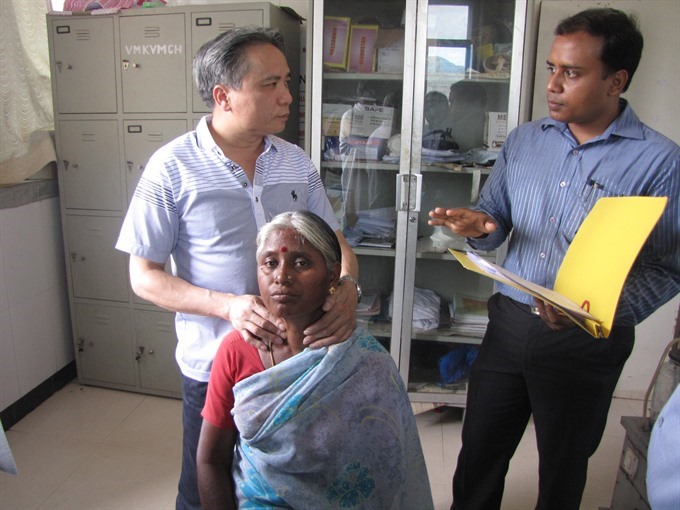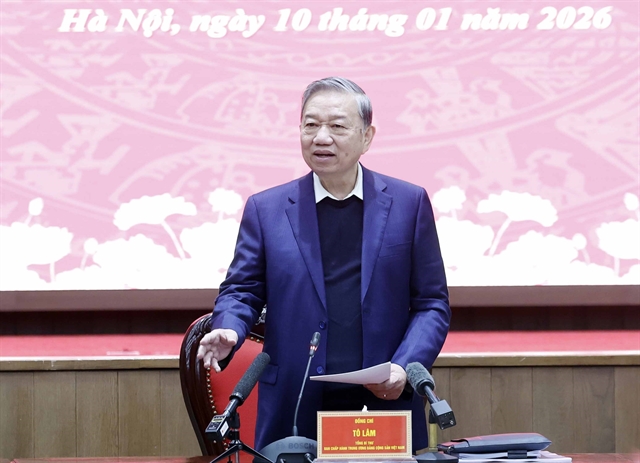 Features
Features

Multiple awards winning Dr Trần Ngọc Lương, Director of the National Hospital of Endocrinology, Head of Surgery Department and Associate Prof. at the Hà Nội Medical University, tells Hà Nguyễn that seeing young women mentally affected by post-surgical scars on their necks motivated him to pioneer a minimally invasive procedure that has since helped thousands in the country.
 |
| Golden hands: Associate Prof.Dr Lương, who pioneered endoscopic treatment of thyroid disorders in Viet Nam and helped patients in several other countries. Photos courtesy of Dr. Lương. |
Multiple awards winning Dr Trần Ngọc Lương, Director of the National Hospital of Endocrinology, Head of Surgery Department and Associate Prof. at the Hà Nội Medical University, tells Hà Nguyễn that seeing young women mentally affected by post-surgical scars on their necks motivated him to pioneer a minimally invasive procedure that has since helped thousands in the country.
Inner Sanctum: You have become famous, in the country and the world, for having “golden hands”. You pioneered endoscopic treatment of thyroid glands in Việt Nam and have tackled cases that are very difficult to operate. You have won many prizes including Việt Nam’s Talent. Tell us something about how all this came about.
The endoscopic technique is an operation with minimal trespass upon surrounding organs. It also enables surgery that does not leave a scar, and helps patients recover soon. Seeing women, particularly young girls, with a scar on their neck, having a really bad psychological effect on them, I told myself that I have to improve the technology to help them.
Inner Sanctum: How did you learn this technique? Can you tell us the story of your first operation on a patient with goitre.
I figured out the technique by myself and then improved on it. I did my first operation on a young female patient in 2003. The operation took more than three hours, compared to less than an hour now. It was because I had to operate carefully to ensure the patient’s safety while taking out the tumour from the patient’s neck.
It was a tough time for me and my team. Thank God our efforts paid off. The patient recovered very soon.
Inner Sanctum: You wrote a thesis on applying endoscopic techniques on treating a number of thyroid gland pathologies. Tell us about that, too.
About 7-10 per cent of women in Việt Nam suffer thyroid gland diseases, particularly goitre, which is located in the front of their neck. In such cases, an open surgery would leave a scar on the neck, which disadvantages young women, particularly who have to interact a lot with others. After the operation, these women have to wear a scarf all year round to cover their scar. Many women told me that they suffered a lot, particularly when it was summer time. For this reason, many women were also not confident about having their operation. Many even died.
So the question of how to help such patients rose repeatedly in my mind, and I thought about using endoscopic techniques on them. It was a great challenge for us at that time, because several doctors had performed abdominal endoscopy successfully, but not on thyroid glands. In fact, the technique was not prevalent the world over. Very few medical institutions were doing it then.
So we were determined to create our own surgical method.
 |
| Healing touch: Dr. Lương examines an Indian patient with goitre. |
Inner Sanctum: What has been the patients’ feedback on this?
Nearly 5,000 Vietnamese and foreign patients have benefited from the technique. Almost all of them are happy because they do not have to live with a scar after the surgery and can confidently interact with people, including their partners and friends. This is the greatest advantage of this technique, besides overall safety and speedier recovery.
Inner Sanctum: Please share with us some of the more memorable stories about the surgeries you have done.
A 62 year-old man in Hà Nội had been undergoing hemodialysis for nearly 10 years and he suffered a terrible itching all day and night. A tumour on his thyroid gland which should have been on his neck had strayed into his chest. Usually doctors have to open the breastbone to get the tumour out but the patient was too weak. I have to use a special lens to light a route for me to stop bleeding to take off the tumour from the patient’s chest without opening his breastbone.
The patient’s itching stopped immediately, because his Parathyorid Hormon (PTH) rate which should be between 15-65 pg/ml, had increased to 1,581 pg/ml, and had reduced after surgery to 15.5 pg/ml. More importantly, the man recovered the next day.
Another patient was from Yên Bái Province. She proposed that I operate on her goitre on Friday so she could go to work next Monday.
I decided to help the young girl. The operation was so successful that the pretty girl was able to return to work on Monday without any scar. She told me that none of her relatives, including her boyfriend, knew about her operation.
Inner Sanctum: Statistics show that 10 per cent of the Vietnamese population has thyroid gland diseases and tumours. The number of female patients is seven times higher than males. How many patients have been operated on in your hospital?
From 2002 to date, we’ve operated on 4,924 patients, most of them women. It is the largest number done by a hospital, not just in Việt Nam, but in the region and the world.
Inner Sanctum: Tell us more about the National Hospital of Endocrinology (NHoE).
In 2000, we were assigned to carry out the national programme against goitre. The number of patients coming to our hospital has increased every year, and it has become even more crowded in recent years. To meet the rising demand, the hospital established the Surgery Department in December 2001. Since then, the hospital has carried out two tasks: Treating patients with thyroid glands diseases and tumours and act to prevent diabetes.
We’ve continuously improved our open and endoscopic surgeries to meet the increasing demand of patients.
I myself have trained hundreds of young Vietnamese surgeons and some 250 doctors from Singapore, Malaysia, Indonesia, the Philippines, Thailand, India, Pakistan, Oman, Saudi Arabia, Australia, Portugal and other countries.
They came to our hospital to learn “ Dr Lương’s technique” and apply it in their countries.
I have been invited 27 times to teach and operate on patients in these countries. Many hospitals in the region and the world are using this technique now.
Inner Sanctum: As a surgeon and the hospital’s director, you must be very busy. How does your family and particularly your wife, assist you?
My wife shares many hardships with me. She has never complained, although I return home very late at night, almost every day.
I have to thank her a lot for doing all the work at home, including taking care of our children since they were young, so that I have had the time to invest in my career and my hospital.
Inner Sanctum: What is your plan this year and the years to come?
I will try my utmost to improve and develop the hospital to save more patients, train young surgeons, expand application of endoscopic surgery to major hospitals in Việt Nam, as also foreign countries. -- VNS




